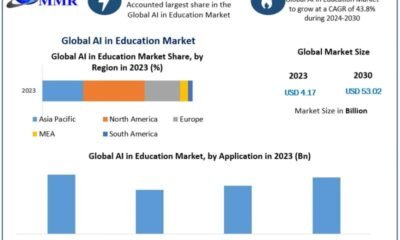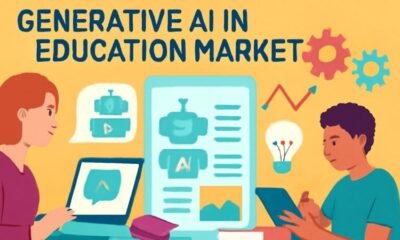By Amy Miller ( September 13, 2025, 00:43 GMT | Comment) — California Gov. Gavin Newsom is facing a balancing act as more than a dozen bills aimed at regulating artificial intelligence tools in a wide range of settings head to his desk for approval. He could approve bills to push back on the Trump administration’s industry-friendly avoidance of AI regulation and make California a model for other states — or he could nix bills to please wealthy Silicon Valley companies and their lobbyists.California Gov. Gavin Newsom is facing a balancing act as more than a dozen bills aimed at regulating artificial intelligence tools in a wide range of settings head to his desk for approval….
AI Insights
Artificial Intelligence (AI) Voice Cloning Market Size

The Artificial Intelligence (AI) Voice Cloning Market is estimated to be valued at approximately USD 280 million in 2024 and is projected to reach around USD 1.85 billion by 2033, growing at a compound annual growth rate (CAGR) of about 21.5% from 2025 to 2033.
Artificial Intelligence (AI) Voice Cloning Market Overview
The Artificial Intelligence (AI) Voice Cloning Market is rapidly expanding as advancements in deep learning and neural networks enable more realistic and customizable synthetic voices. Voice cloning technology is increasingly being adopted across industries such as entertainment, gaming, customer service, and healthcare for applications like personalized voice assistants, dubbing, and accessibility solutions. The growing demand for natural-sounding AI voices and multilingual support is driving innovation and market growth. However, concerns around privacy, ethical use, and potential misuse of cloned voices pose challenges that the industry is actively addressing through regulation and technological safeguards. Furthermore, improvements in cloud computing and AI algorithms are making voice cloning more accessible and cost-effective for businesses. Overall, the market is poised for significant growth, fueled by increasing adoption and continuous technological advancements.
Request a sample copy of this report at: https://www.omrglobal.com/request-sample/artificial-intelligence-voice-cloning-market
Advantages of requesting a Sample Copy of the Report:
1) To understand how our report can bring a difference to your business strategy
2) To understand the analysis and growth rate in your region
3) Graphical introduction of global as well as the regional analysis
4) Know the top key players in the market with their revenue analysis
5) SWOT analysis, PEST analysis, and Porter’s five force analysis
The report further explores the key business players along with their in-depth profiling
ElevenLabs, Murf.AI, Respeecher, Descript, Play.ht, WellSaid Labs, iSpeech, CandyVoice, Replica Studios, and VocaliD.
Artificial Intelligence (AI) Voice Cloning Market Segments:
By Technology:
• Text-to-Speech (TTS)
• Neural Voice Cloning
• Speaker Adaptation
By Application:
• Media & Entertainment
• Healthcare
• Education & E-learning
• Customer Support & Virtual Assistants
• Automotive
• Telecommunications
By End User:
• Enterprises
• Individual Consumers
• Content Creators
By Deployment Mode:
• Cloud-based
• On-premise
Report Drivers & Trends Analysis:
The report also discusses the factors driving and restraining market growth, as well as their specific impact on demand over the forecast period. Also highlighted in this report are growth factors, developments, trends, challenges, limitations, and growth opportunities. This section highlights emerging Artificial Intelligence (AI) Voice Cloning Market trends and changing dynamics. Furthermore, the study provides a forward-looking perspective on various factors that are expected to boost the market’s overall growth.
Competitive Landscape Analysis:
In any market research analysis, the main field is competition. This section of the report provides a competitive scenario and portfolio of the Artificial Intelligence (AI) Voice Cloning Market’s key players. Major and emerging market players are closely examined in terms of market share, gross margin, product portfolio, production, revenue, sales growth, and other significant factors. Furthermore, this information will assist players in studying critical strategies employed by market leaders in order to plan counterstrategies to gain a competitive advantage in the market.
Regional Outlook:
The following section of the report offers valuable insights into different regions and the key players operating within each of them. To assess the growth of a specific region or country, economic, social, environmental, technological, and political factors have been carefully considered. The section also provides readers with revenue and sales data for each region and country, gathered through comprehensive research. This information is intended to assist readers in determining the potential value of an investment in a particular region.
» North America (U.S., Canada, Mexico)
» Europe (Germany, U.K., France, Italy, Russia, Spain, Rest of Europe)
» Asia-Pacific (China, India, Japan, Singapore, Australia, New Zealand, Rest of APAC)
» South America (Brazil, Argentina, Rest of SA)
» Middle East & Africa (Turkey, Saudi Arabia, Iran, UAE, Africa, Rest of MEA)
If you have any special requirements, Request customization: https://www.omrglobal.com/report-customization/artificial-intelligence-voice-cloning-market
Key Benefits for Stakeholders:
⏩ The study represents a quantitative analysis of the present Artificial Intelligence (AI) Voice Cloning Market trends, estimations, and dynamics of the market size from 2025 to 2032 to determine the most promising opportunities.
⏩ Porter’s five forces study emphasizes the importance of buyers and suppliers in assisting stakeholders to make profitable business decisions and expand their supplier-buyer network.
⏩ In-depth analysis, as well as the market size and segmentation, help you identify current Artificial Intelligence (AI) Voice Cloning Market opportunities.
⏩ The largest countries in each region are mapped according to their revenue contribution to the market.
⏩ The Artificial Intelligence (AI) Voice Cloning Market research report gives a thorough analysis of the current status of the Artificial Intelligence (AI) Voice Cloning Market’s major players.
Key questions answered in the report:
➧ What will the market development pace of the Artificial Intelligence (AI) Voice Cloning Market?
➧ What are the key factors driving the Artificial Intelligence (AI) Voice Cloning Market?
➧ Who are the key manufacturers in the market space?
➧ What are the market openings, market hazards,s and market outline of the Artificial Intelligence (AI) Voice Cloning Market?
➧ What are the sales, revenue, and price analysis of the top manufacturers of the Artificial Intelligence (AI) Voice Cloning Market?
➧ Who are the distributors, traders, and dealers of Artificial Intelligence (AI) Voice Cloning Market?
➧ What are the market opportunities and threats faced by the vendors in the Artificial Intelligence (AI) Voice Cloning Market?
➧ What are deals, income, and value examination by types and utilizations of the Artificial Intelligence (AI) Voice Cloning Market?
➧ What are deals, income, and value examination by areas of enterprises in the Artificial Intelligence (AI) Voice Cloning Market?
Purchase Now Up to 25% Discount on This Premium Report: https://www.omrglobal.com/buy-now/artificial-intelligence-voice-cloning-market?license_type=quick-scope-report
Reasons To Buy The Artificial Intelligence (AI) Voice Cloning Market Report:
➼ In-depth analysis of the market on the global and regional levels.
➼ Major changes in market dynamics and competitive landscape.
➼ Segmentation on the basis of type, application, geography, and others.
➼ Historical and future market research in terms of size, share growth, volume, and sales.
➼ Major changes and assessment in market dynamics and developments.
➼ Emerging key segments and regions
➼ Key business strategies by major market players and their key methods
Contact Us:
Mr. Anurag Tiwari
Email: anurag@omrglobal.com
Contact no: +91 780-304-0404
Website: www.omrglobal.com
Follow Us: LinkedIn | Twitter
About Orion Market Research
Orion Market Research (OMR) is a market research and consulting company known for its crisp and concise reports. The company is equipped with an experienced team of analysts and consultants. OMR offers quality syndicated research reports, customized research reports, consulting and other research-based services. The company also offers Digital Marketing services through its subsidiary OMR Digital and Software development and Consulting Services through another subsidiary Encanto Technologies.
This release was published on openPR.
AI Insights
Artificial intelligence helps break barriers for Hispanic homeownership | Business

We recognize you are attempting to access this website from a country belonging to the European Economic Area (EEA) including the EU which
enforces the General Data Protection Regulation (GDPR) and therefore access cannot be granted at this time.
For any issues, contact jgnews@jg.net or call 260-461-8773.
AI Insights
UW lab spinoff focused on AI-enabled protein design cancer treatments

A Seattle startup company has inked a deal with Eli Lilly to develop AI powered cancer treatments. The team at Lila Biologics says they’re pioneering the translation of AI design proteins for therapeutic applications. Anindya Roy is the company’s co-founder and chief scientist. He told KUOW’s Paige Browning about their work.
This interview has been edited for clarity.
Paige Browning: Tell us about Lila Biologics. You spun out of UW Professor David Baker’s protein design lab. What’s Lila’s origin story?
Anindya Roy: I moved to David Baker’s group as a postdoctoral scientist, where I was working on some of the molecules that we are currently developing at Lila. It is an absolutely fantastic place to work. It was one of the coolest experiences of my career.
The Institute for Protein Design has a program called the Translational Investigator Program, which incubates promising technologies before it spins them out. I was part of that program for four or five years where I was generating some of the translational data. I met Jake Kraft, the CEO of Lila Biologics, at IPD, and we decided to team up in 2023 to spin out Lila.
You got a huge boost recently, a collaboration with Eli Lilly, one of the world’s largest pharmaceutical companies. What are you hoping to achieve together, and what’s your timeline?
The current collaboration is one year, and then there are other targets that we can work on. We are really excited to be partnering with Lilly, mainly because, as you mentioned, it is one of the top pharma companies in the US. We are excited to learn from each other, as well as leverage their amazing clinical developmental team to actually develop medicine for patients who don’t have that many options currently.
You are using artificial intelligence and machine learning to create cancer treatments. What exactly are you developing?
Lila Biologics is a pre-clinical stage company. We use machine learning to design novel drugs. We have mainly two different interests. One is to develop targeted radiotherapy to treat solid tumors, and the second is developing long acting injectables for lung and heart diseases. What I mean by long acting injectables is something that you take every three or six months.
Tell me a little bit more about the type of tumors that you are focusing on.
We have a wide variety of solid tumors that we are going for, lung cancer, ovarian cancer, and pancreatic cancer. That’s something that we are really focused on.
And tell me a little bit about the partnership you have with Eli Lilly. What are you creating there when it comes to cancers?
The collaboration is mainly centered around targeted radiotherapy for treating solid tumors, and it’s a multi-target research collaboration. Lila Biologics is responsible for giving Lilly a development candidate, which is basically an optimized drug molecule that is ready for FDA filing. Lilly will take over after we give them the optimized molecule for the clinical development and taking those molecules through clinical trials.
Why use AI for this? What edge is that giving you, or what opportunities does it have that human intelligence can’t accomplish?
In the last couple of years, artificial intelligence has fundamentally changed how we actually design proteins. For example, in last five years, the success rate of designing protein in the computer has gone from around one to 2% to 10% or more. With that unprecedented success rate, we do believe we can bring a lot of drugs needed for the patients, especially for cancer and cardiovascular diseases.
In general, drug design is a very, very difficult problem, and it has really, really high failure rates. So, for example, 90% of the drugs that actually enter the clinic actually fail, mainly due to you cannot make them in scale, or some toxicity issues. When we first started Lila, we thought we can take a holistic approach, where we can actually include some of this downstream risk in the computational design part. So, we asked, can machine learning help us designing proteins that scale well? Meaning, can we make them in large scale, or they’re stable on the benchtop for months, so we don’t face those costly downstream failures? And so far, it’s looking really promising.
When did you realize you might be able to use machine learning and AI to treat cancer?
When we actually looked at this problem, we were thinking whether we can actually increase the clinical success rate. That has been one of the main bottlenecks of drug design. As I mentioned before, 90% of the drugs that actually enter the clinic fail. So, we are really hoping we can actually change that in next five to 10 years, where you can actually confidently predict the clinical properties of a molecule. In other words, what I’m trying to say is that can you predict how a molecule will behave in a living system. And if we can do that confidently, that will increase the success rate of drug development. And we are really optimistic, and we’ll see how it turns out in the next five to 10 years.
Beyond treating hard to tackle tumors at Lila, are there other challenges you hope to take on in the future?
Yeah. It is a really difficult problem to predict how a molecule will behave in a living system. Meaning, we are really good at designing molecules that behave in a certain way, bind to a protein in a certain way, but the moment you try to put that molecule in a human, it’s really hard to predict how that molecule will behave, or whether the molecule is going to the place of the disease, or the tissue of the disease. And that is one of the main reasons there is a 90% failure in drug development.
I think the whole field is moving towards this predictability of biological properties of a molecule, where you can actually predict how this molecule will behave in a human system, or how long it will stay in the body. I think when the computational tools become good enough, when we can predict these properties really well, I think that’s where the fun begins, and we can actually generate molecules with a really high success rate in a really short period of time.
Listen to the interview by clicking the play button above.
AI Insights
California governor facing balancing act as AI bills head to his desk | MLex
Prepare for tomorrow’s regulatory change, today
MLex identifies risk to business wherever it emerges, with specialist reporters across the globe providing exclusive news and deep-dive analysis on the proposals, probes, enforcement actions and rulings that matter to your organization and clients, now and in the longer term.
Know what others in the room don’t, with features including:
- Daily newsletters for Antitrust, M&A, Trade, Data Privacy & Security, Technology, AI and more
- Custom alerts on specific filters including geographies, industries, topics and companies to suit your practice needs
- Predictive analysis from expert journalists across North America, the UK and Europe, Latin America and Asia-Pacific
- Curated case files bringing together news, analysis and source documents in a single timeline
Experience MLex today with a 14-day free trial.
-

 Business2 weeks ago
Business2 weeks agoThe Guardian view on Trump and the Fed: independence is no substitute for accountability | Editorial
-
Tools & Platforms1 month ago
Building Trust in Military AI Starts with Opening the Black Box – War on the Rocks
-

 Ethics & Policy2 months ago
Ethics & Policy2 months agoSDAIA Supports Saudi Arabia’s Leadership in Shaping Global AI Ethics, Policy, and Research – وكالة الأنباء السعودية
-

 Events & Conferences4 months ago
Events & Conferences4 months agoJourney to 1000 models: Scaling Instagram’s recommendation system
-

 Jobs & Careers2 months ago
Jobs & Careers2 months agoMumbai-based Perplexity Alternative Has 60k+ Users Without Funding
-

 Podcasts & Talks2 months ago
Podcasts & Talks2 months agoHappy 4th of July! 🎆 Made with Veo 3 in Gemini
-

 Education2 months ago
Education2 months agoMacron says UK and France have duty to tackle illegal migration ‘with humanity, solidarity and firmness’ – UK politics live | Politics
-

 Education2 months ago
Education2 months agoVEX Robotics launches AI-powered classroom robotics system
-

 Funding & Business2 months ago
Funding & Business2 months agoKayak and Expedia race to build AI travel agents that turn social posts into itineraries
-

 Podcasts & Talks2 months ago
Podcasts & Talks2 months agoOpenAI 🤝 @teamganassi



















